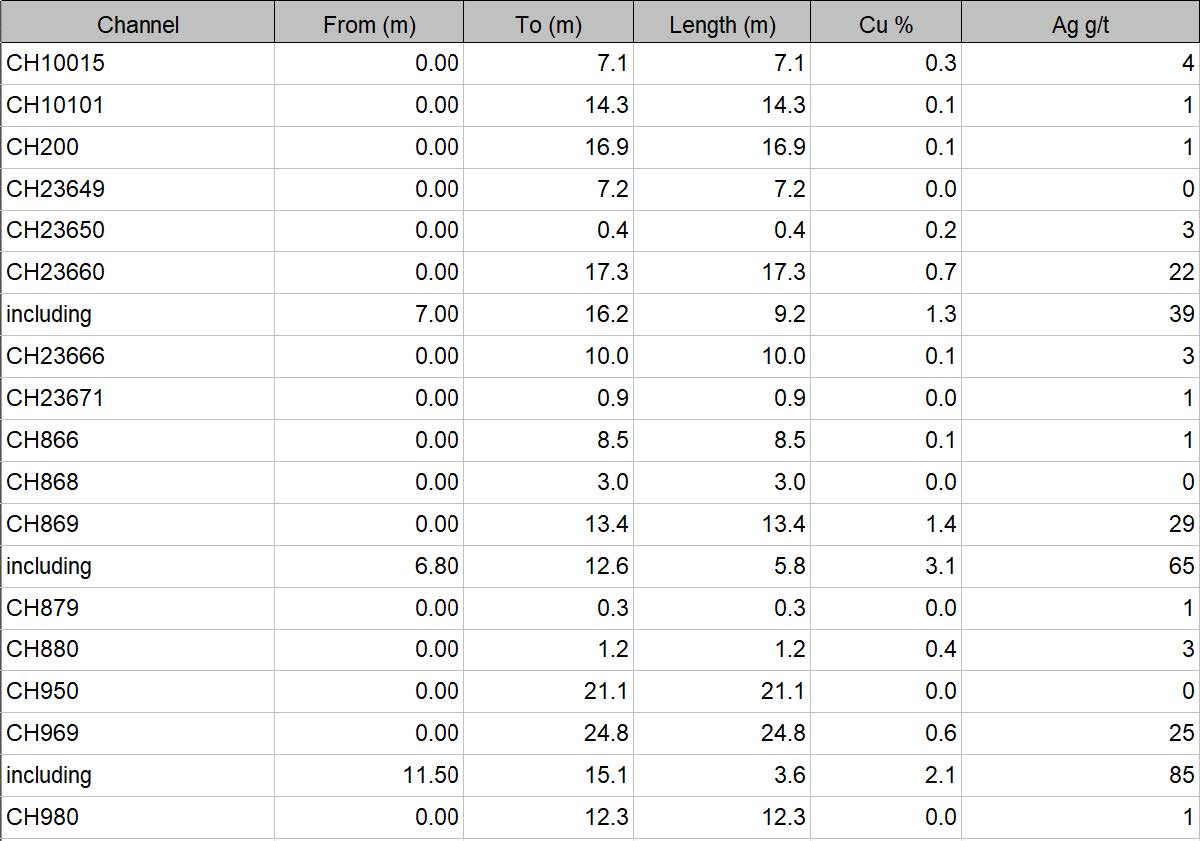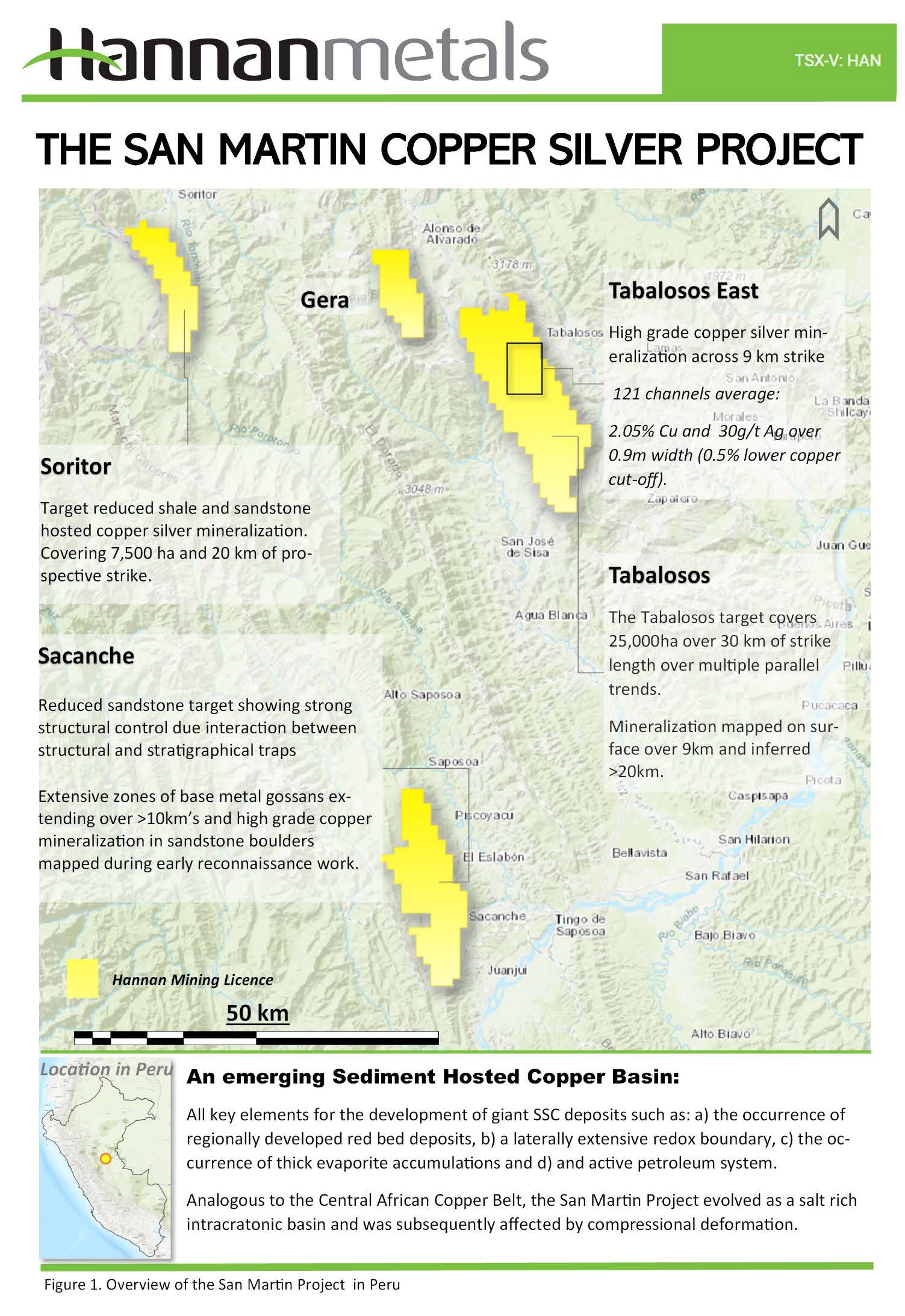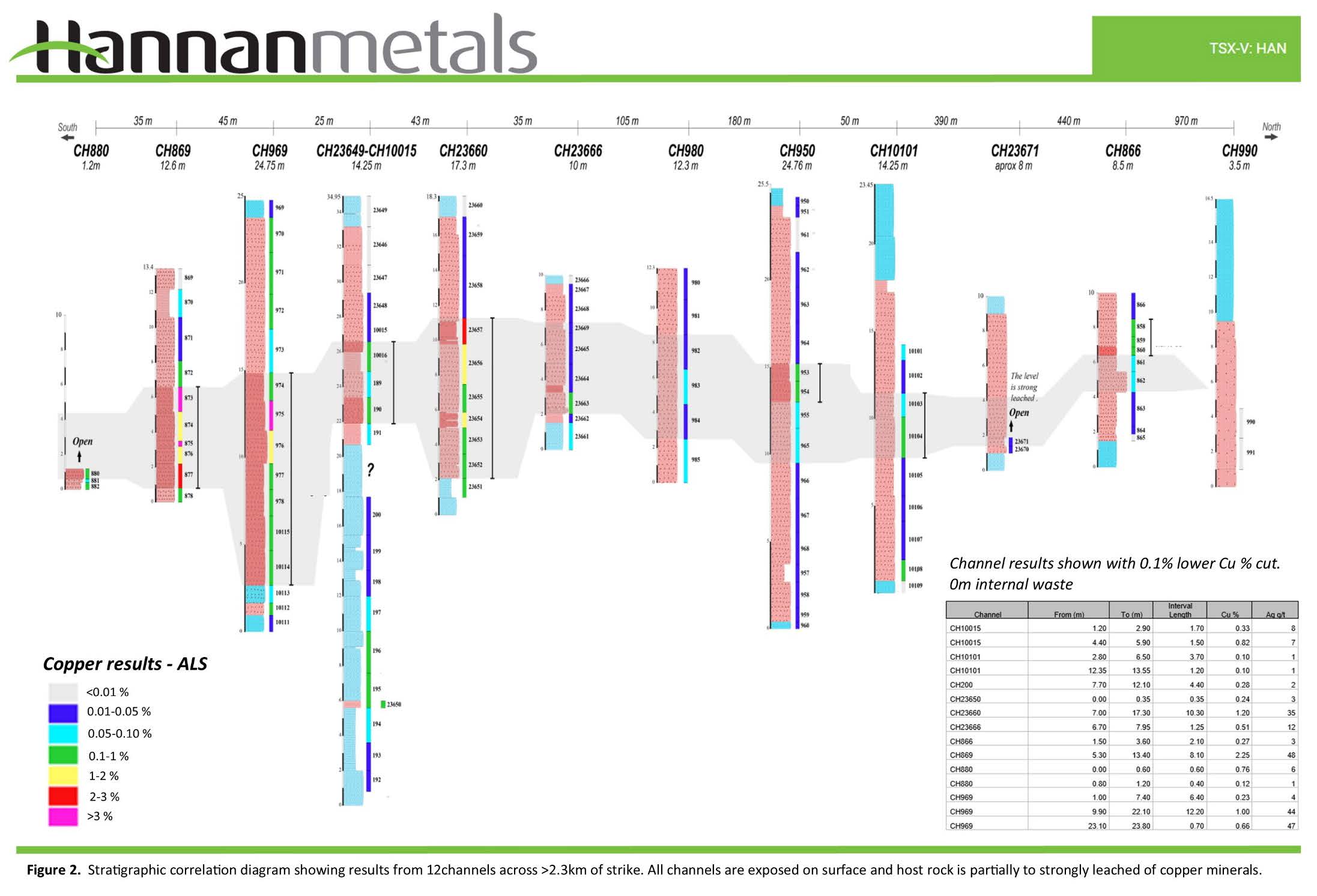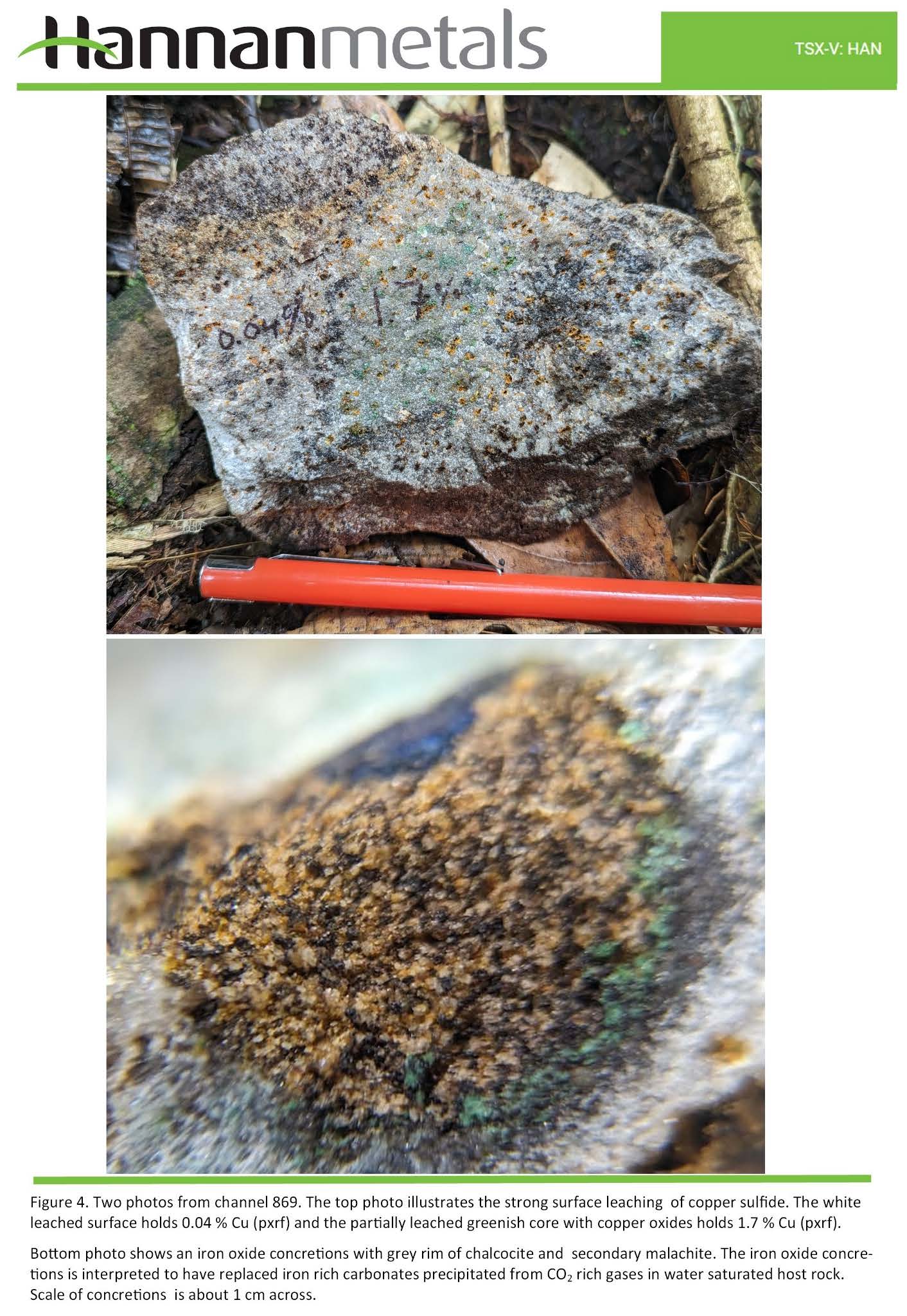Vancouver, Canada – Hannan Metals Limited (“Hannan” or the “Company”) (TSXV: HAN) (OTCPK: HANNF) is pleased announce that it has discovered a new style of sediment hosted copper-silver mineralization at San Martin West located within the San Martin project in northern Peru (Figure 1).
The mineralization is outcropping and has been mapped over 2.3 km of strike. It is located in a new area 45 km west from the recently approved drill permit area at Tabalosos East.
Highlights:
- Outcropping copper-silver mineralization has been mapped for over 2.3 km of strike (Figure 2) including 5.8 m at 3.1% copper and 65 g/t silver from surface.
- Copper mineralization is locally high-grade and chalcocite dominant. Surface outcrops are strongly leached (Figures 3 and 4) suggesting higher-grade copper mineralization may exist below the weathered surface outcrops.
- The host rock is a medium grained reduced sandstone and sedimentary breccia. Hypogene copper minerals are dominated by chalcocite, but locally bornite, chalcopyrite and pyrite are observed in hand samples. Copper sulfides have precipitated on the rims of carbonate concentrations (interpreted to have formed from methane and CO2 rich gases) and on organic carbon clasts within the host rocks.
Michael Hudson, Chairman and CEO, states “This is an exciting new discovery demonstrating consistently thick (>10 m wide) zones of high-grade copper and silver mineralization over multiple kms of strike length. Copper mineralization of this style and tenor was previously unknown at the San Martin project until these recent discoveries. This new discovery is located 45 km west from the recently granted drill program (DIA Tabalosos East). We are looking forward to advancing this new discovery with more detailed geological mapping and geochemical sampling while we also prepare for the upcoming drill program at Tabalosos”.
Geological discussion
The San Martin Project covers a new, basin-scale high-grade sediment-hosted copper-silver system that extends over 200 km x 100 km along the foreland region of the eastern Andes Mountains. Mineralization is geologically similar to the vast Kupferschiefer deposits in Eastern Europe. Sediment-hosted stratiform copper-silver deposits are among the two most important copper sources in the world, the other being copper porphyries.
The new discovery at San Martin West was made during follow-up of BLEG samples during 2023. To date mineral prospecting has been focusing on surface sampling and mapping in ravines and systematic soil samples on topographic ridge lines. Outcropping is scarce in the area and the whole area is covered by dense vegetation.
The mineralization is hosted by a 10 m to 30 m thick stratigraphic unit composed of medium to coarse grained sandstone and sedimentary breccia which has been traced for >2.3 km that remains open along strike to the North. Figure 2 shows a stratigraphic correlation diagram showing results from the 12 channels across >2.3 km of strike. All channels are exposed on surface and the host rock is partially to strongly leached of copper minerals.
The unit hosts rich disseminated iron oxide concentrations after carbonates (siderite and ankerite). The concentration varies from 10% to >50% of the volume of the host rock. Stratigraphically it is situated some 50 m from the contact to the Cretaceous Cushabatay Formation. Both the hanging-wall and the foot-wall of the sandstone is composed of fine-grained red siltstone of the Sarayaquillo Formation.
Carbonate concretions may form under a variety of geological conditions. However, the mapped outcrop shows a composition and texture similar to mapped paleoflows of ancient carbon dioxide (CO2) driven gas systems (Loope 2015). Therefore, Hannan interprets the concretions to be remnants of methane and CO2 rich gases that have participated carbonates in a water saturated host rock. Reduction of the host rock occurred during gas and host rock interaction resulting in bleaching of a red oxidized sandstone to the current white and reduced sandstone host.
Supergene copper mineralization is common and dominated by neotocite, tenorite and malachite. Hypogene copper minerals are dominated by chalcocite, but locally bornite, chalcopyrite and pyrite are observed in hand samples. Copper sulfides have precipitated on the rims of carbonate concentrations and on organic carbon clasts within the host rocks (Figure 4). Paleomicrobial activity feeding on the primary carbonate concretions may have formed an important part of the trap for the oxidized copper rich fluids and explain why chalcocite is rimming the carbonate concretions.
The copper mineralization at surface is strongly leached and copper sulfides are dominantly preserved in weathering resistant silicified zones. The company expects that high grade copper mineralization extends into zones of less intense weathering at depth.
Detailed geochemical sampling by handheld pXRF units has commenced and results will be released once the program has been completed. Weighted averages of twelve channels sampled over 2.3 km averaged 13.2 m @ 0.3% Cu and 9 g/t Ag. Max 13.4 m @ 1.4% Cu and 29 g/t Ag, min 7.2 m @ 0.0 % Cu and 0 g/t Ag. (Table 1).
Compared to the Tabalosos project area, which is located 45 km to the east, the new discovery is hosted 200 m to 300 m higher in the stratigraphy.
San Martin Copper-Silver Project
Sediment-hosted stratiform copper-silver deposits are among the two most important copper sources in the world, the other being copper porphyries. They are also a major producer of silver. KGHM Polska Miedz’s (“KGHM”) three copper-silver sediment-hosted mines in Poland (the “Kupferschiefer”) were the leading silver producer in the world and seventh largest global copper miner in 2020. Quoted resources in 2019 for KGHM were 1,518 Mt @ 1.86% copper and 55 g/t silver from a mineralized zone that averages 0.4 m to 5.5 m thickness.
To provide context, Hannan’s widths and grade (0.9 m @ 1.9 % copper and 27 g/t silver) from 105 channel surface samples reported at Tabalosos East (lower cut 0.5% copper), within an area about 9 km long and 1 km wide, compare with those found during the initial modern-day drill discovery of the Kupferschiefer copper-silver deposits (Figure 2).
- In 1957 the discovery drillhole (Sieroszowice IG 1) intersected 2.0 m @ 1.5% copper at the depth of 657 m.
- In 1959 the Lubin-Sieroszowice deposit, based on the results from 24 drillholes contained 1,365 Mt @ 1.4% copper and 26 g/t silver in indicated resources, with a thickness ranging between 0.2 m to 13.1 m in an area about 28 km long and 6 km wide between 400 m and 1,000 m depth.
Hannan’s sampling, to date, has been confined to surface channel sampling, although mineralization at Tabalosos East is interpreted to extend with shallow dips to the west for between 2 km to 4 km, with a target depth ranging from surface to 500 m.
Table 1 Channel results shown with 0.1% Cu lower-cut with higher grade intervals 1.0% Cu lower cut
JOGMEC Joint Venture
On November 27, 2020, as amended April 17, 2023, Hannan signed a binding letter agreement for an Option and Joint Venture Agreement (the “JOGMEC Agreement”) with the Japan Organization for Metals and Energy Security (“JOGMEC”). Under the JOGMEC Agreement, JOGMEC has the option to earn up to a 75% beneficial interest in the San Martin JV Project by spending up to US $35,000,000 to deliver to the joint venture (“JV”) a feasibility study.
Technical Background
All samples were collected by Hannan geologists. Samples were transported to ALS in Lima via third party services using traceable parcels. At the laboratory, rock samples were prepared and analyzed by standard methods. The sample preparation involved crushing 70% to less than 2 mm, riffle split off 250g, pulverize split to better than 85% passing 75 microns. Samples were analyzed by method ME-MS61, a four-acid digest preformed on 0.25g of the sample to quantitatively dissolve most geological materials. Analysis is via ICP-MS. Channel samples are considered representative of the in-situ mineralization samples and sample widths quoted approximate the true width of mineralization, while grab samples are selective by nature and are unlikely to represent average grades on the property. Gold was analyzed by ALS in Lima using a standard sample preparation and 25g fire assay sample charge.
About Hannan Metals Limited (TSXV:HAN) (OTCPK: HANNF)
Hannan Metals Limited is a natural resources and exploration company developing sustainable resources of metal needed to meet the transition to a low carbon economy. Over the last decade, the team behind Hannan has forged a long and successful record of discovering, financing, and advancing mineral projects in Europe and Peru. Hannan is a top ten in-country explorer by area in Peru.
Mr. Michael Hudson FAusIMM, Hannan’s Chairman and CEO, a Qualified Person as defined in National Instrument 43-101, has reviewed and approved the technical disclosure contained in this news release.
On behalf of the Board, "Michael Hudson" Michael Hudson, Chairman & CEO | Further Information |
Forward Looking Statements. Certain disclosure contained in this news release may constitute forward-looking information or forward-looking statements, within the meaning of Canadian securities laws. These statements may relate to this news release and other matters identified in the Company's public filings. In making the forward-looking statements the Company has applied certain factors and assumptions that are based on the Company's current beliefs as well as assumptions made by and information currently available to the Company. These statements address future events and conditions and, as such, involve known and unknown risks, uncertainties and other factors which may cause the actual results, performance or achievements to be materially different from any future results, performance or achievements expressed or implied by the statements. These risks and uncertainties include but are not limited to: the political environment in which the Company operates continuing to support the development and operation of mining projects; the threat associated with outbreaks of viruses and infectious diseases; risks related to negative publicity with respect to the Company or the mining industry in general; planned work programs; permitting; and community relations. Readers are cautioned not to place undue reliance on forward-looking statements. The Company does not intend, and expressly disclaims any intention or obligation to, update or revise any forward-looking statements whether as a result of new information, future events or otherwise, except as required by law.
Neither the TSX Venture Exchange nor its Regulation Services Provider (as that term is defined in the policies of the TSX Venture Exchange) accepts responsibility for the adequacy or accuracy of this news.






